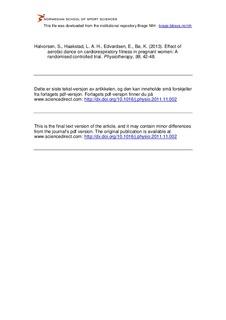| dc.contributor.author | Halvorsen, Silje | |
| dc.contributor.author | Haakstad, Lene Annette Hagen | |
| dc.contributor.author | Edvardsen, Elisabeth | |
| dc.contributor.author | Bø, Kari | |
| dc.date.accessioned | 2013-10-29T09:25:17Z | |
| dc.date.available | 2013-10-29T09:25:17Z | |
| dc.date.issued | 2013-03 | |
| dc.identifier | Seksjon for idrettsmedisinske fag / Department of Sports Medicine | |
| dc.identifier.citation | Physiotherapy. 2013, 99, 42-48 | no_NO |
| dc.identifier.uri | http://hdl.handle.net/11250/170992 | |
| dc.description | I Brage finner du siste tekst-versjon av artikkelen, og den kan inneholde ubetydelige forskjeller fra forlagets pdf-versjon. Forlagets pdf-versjon finner du på www.sciencedirect.com: http://dx.doi.org/10.1016/j.physio.2011.11.002 / In Brage you'll find the final text version of the article, and it may contain insignificant differences from the journal's pdf version. The original publication is available at www.sciencedirect.com: http://dx.doi.org/10.1016/j.physio.2011.11.002 | no_NO |
| dc.description.abstract | Objective: To evaluate the effectiveness of aerobic dance on cardiorespiratory fitness in pregnant women.
Design: Randomised controlled trial.
Participants: Sixty-two primiparous women with a mean age of 30.6 [standard deviation (SD) 3.7] years randomised to exercise (n = 34) and (n = 28) control groups.
Intervention: Two aerobic dance classes per week and 30 minutes of daily self-imposed physical activity for 12 weeks.
Main outcome measure: Cardiorespiratory fitness, assessed using a submaximal treadmill test to establish oxygen uptake (VO2) (ml/kg/minute) at three different levels of blood lactate. Levels 1, 2 and 3 were calculated and defined as 0.5, 1.0 and 1.5 mmol/l above resting blood lactate level, respectively.
Results: The women in the exercise group attended a mean of 20 (SD 12) out of 24 aerobic dance classes. Both groups had a small significant decrease in VO2 between baseline and post-intervention: the exercise group decreased from 25.8 (SD 3.3) to 24.5 (SD 3.8) ml/kg/minute and the control group decreased from 25.8 (SD 3.1) to 24.5 (SD 2.5) ml/kg/minute at Level 3 (anaerobic threshold) (mean difference in change at Level 3 = 0.1, 95% confidence interval −1.4 to 1.7; P = 0.89). There were no differences in change between the groups at any level.
Conclusion: A 12-week aerobic dance programme had no effect on cardiorespiratory fitness in pregnant women. | no_NO |
| dc.language.iso | eng | no_NO |
| dc.publisher | Elsevier | no_NO |
| dc.subject | aerobic dance | no_NO |
| dc.subject | cardiorespiratory fitness | no_NO |
| dc.subject | pregnancy | no_NO |
| dc.title | Effect of aerobic dance on cardiorespiratory fitness in pregnant women: A randomised controlled trial | no_NO |
| dc.type | Journal article | no_NO |
| dc.type | Peer reviewed | no_NO |
| dc.subject.nsi | VDP::Medical disciplines: 700::Health sciences: 800::Physiotherapy: 807 | no_NO |
| dc.source.journal | Physiotherapy | no_NO |
| dc.identifier.doi | 10.1016/j.physio.2011.11.002 | |
